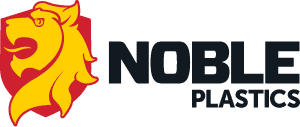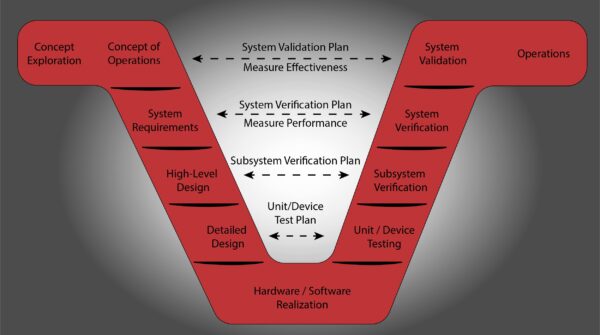There are ‘smart technology’ solutions everywhere now that claim to increase your operational efficiency by up to 30%. What if it helps a shop to become 5% more efficient? What is a single percent of better efficiency worth?
At Noble Plastics, we tackle every plastic injection molding project using a systems engineering approach, a methodology widely used in the defense industry. This is also referred to as the V-method. Our thorough and methodical approach to product realization and delivery ensures we capture all performance requirements, implement methods for achieving them, and can prove we have met them. The left side of the V is the discovery and design phases, and the right side coordinates to the left with testing and validation.
Even when a client has a fully designed and implemented product, our approach ensures we completely understand their needs to provide the best possible service. Below, we will go into more detail about how each step of the process is approached.
Concept Exploration and Concept of Operations
When a customer comes to us with a new project, these are the first steps of our methodology. Exploration may be done by the customer as they identify an issue, what part or parts they need, and any constraints. Within the concept of operations, we collaborate to discover the objectives, what pieces are involved, how they will be used, who the stakeholders are, how we will measure success, what type of testing is involved, and whether we can do it in-house. This sets the foundation for the success of the program.
System Requirements Review
Once we understand the project’s scope, we ensure the system’s requirements are defined, consistent, and complete. A system can refer to a single part or an assembly of multiple parts. This review assesses whether the project is ready to proceed to the design phase. Stakeholders, including engineers, project managers, and clients, evaluate the requirements, which might include a size dimension, tolerances, testing, visual defect allowances, fit, or functionality. Requirements must be measurable. We like to know why a part has a particular design, material, tolerance, etc., to understand what can and cannot be modified during the design phases to make the part more efficient or reduce costs.
High-Level Design Review
This stage focuses on the overall design and structure of the product, providing a big-picture view. It outlines the main components and how they interact, evaluating dimensions, material selection, and physical properties required (e.g., thermal, electrical, strength). We also examine secondary processes, assembly, and packaging. The goal is to confirm that the planned design is feasible.
Detailed Design
The detailed design is the final design phase and covers specifics of the design, such as exact dimensions and tolerances. We use cutting-edge simulation, modeling software, heat sink analysis, and a design for manufacturing (DFM) approach to ensure the part can be efficiently manufactured. Dimensional drawings with tolerances are finalized in this step.
A technical readiness assessment is done in parallel with high-level and detailed designs. We look at all the system elements, whether a material, a part or number of parts, or a manufacturing method and determine and grade how ready that technology is for implementation. If it is something that has been done hundreds of times or a commonly used material, for example, it will be graded with a high level of technical readiness. Whereas a new material, for example, would have a low level of technical readiness. This assessment helps us to evaluate risk upfront so we can communicate to the stakeholders involved. It gives us insight into whether we need to determine testing methods, prototyping methods, or other ways to mitigate the risk.
Hardware / Software Realization
This is also called the implementation stage, where the planning and design are executed. At this point, if equipment, automation, or programming are needed, those processes will be performed. In addition, a prototype can be manufactured to the part specifications. A prototype will tell us if the part can be manufactured and if it behaves as it should. The following steps on the upside of the V are where it gets tested and validated to prove the requirements were met.
Unit/Device Testing
The symmetry of the V reflects the relationship between different steps on the left and right. Unit testing is executing the test plan from the final design phase. The part will be checked for dimensional accuracy and defects, for example.
Subsystem Verification and System Verification
Verification is proving that the part accurately depicts the conceptual description and specifications. Depending on the complexity, if there are one or more components and other systems (molding, post-mold processing, assembly, packaging, etc.), system and subsystem verification may be done separately or together. We are verifying that processes interact correctly. This measures the performance of the high-level design and system requirements established on the left side of the V.
System Validation
System validation measures the effectiveness of the complete system. Does the part do what it was intended to do within the real world? For example, if the part is used in a control panel, will it fit and work as intended in relation to other components and the panel as a whole?
Operations
During the operations phase, we move into full-scale production. By implementing the multistep systems engineering approach, we have ensured that the products that are manufactured will meet all requirements.
Our Systems Engineering Approach Can Work For You
Working with a new injection molder means putting your trust in them that they can deliver products that meet your specifications. Our systems engineering approach ensures consistency in our manufacturing methods, no steps are skipped, and all aspects of design and operations are well thought out so that every product you receive is exactly as expected. Contact us to get started.
MORE N-SIGHTS™
Force Sensitive Molding
I fear nothing. For all is as the Force wills it.
-Chirrut Îmwe Rogue One: A Star Wars Story
A simple statement in a galaxy far, far away and a simple truth in injection molding. So much so that Noble utilizes an array of in-mold sensors to help troubleshoot and monitor the molding process.
How Lot and In-Shift Inspections Contribute to a Closed-Loop Quality System
A closed-loop quality system is crucial to consistently produce high-quality parts and demonstrates that commitment. Learn more.


